 |
| |
|
| |
Butterfly gardening involves planning your garden to attract, retain, and encourage butterfly populations. A sample garden plan is shown in Figure 1, and a list of host plants is given in Table 3 and Table 4. Flowers of similar colors grouped together are more attractive to both butterflies and the gardener.
You should select a variety of nectar-producing plants with the aim of providing flowers in bloom throughout the season. This will entice a continuous succession of new visitors to a yard. It is especially important to have flowers in mid to late summer, when most butterflies are active. Flowers with multiple florets that produce abundant nectar are ideal.
Annuals are wonderful butterfly plants because they bloom continuously through the season, providing a steady supply of nectar. Perennial plants, such as coneflowers, lilac, butterfly weed, and asters, are visited regularly by butterflies. Most plants in the mint family are also good nectar sources for butterflies. Avoid double flowers because they are often bred for showiness, not nectar production.
You can supplement the garden’s flower nectar with a home-made feeder. Made from an inverted baby food or other small jar, such a feeder can be attractive to butterflies. Drill a small hole in the center of the lid and plug it with cotton. Fill the jar with a solution of one part sugar (not honey) to nine parts water. Attach brightly-colored fabric petals to the lid to make the feeder more appealing to butterflies. Hang your feeder in a tree near your garden.
For successful butterfly gardening, you need to provide food for more than the adult butterflies. You need to provide for their caterpillar forms as well. Butterfly caterpillars have a limited host range (See Table 2). Most caterpillars feed on leaves; although some develop on the reproductive parts of flowers or seeds.
Some supposedly good butterfly plants might not attract butterflies in your garden. It may be that a particular plant is not the preferred larval food of local butterflies (see Table 2 for preferred plants).
 |
| |
|
| |
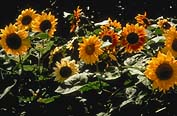 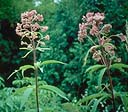 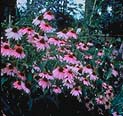 Plantings of host plants preferred by butterflies does not require any sacrifice of flowers and colors. Plants such as (first column) yellow sunflower, pink Joe-Pye weed, purple coneflower, and (second column) purple verbena, yellow Black-eyed Susan, red bee balm/bergamot, and purple wild asters provide plentiful color. |
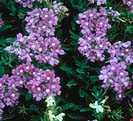 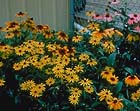 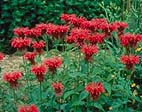  |
Successful butterfly gardening includes more than providing larval host plants and nectar sources. It includes planning appropriate habitats for these useful and beautiful creatures. For instance, shelter is important to butterflies for a number of reasons. Butterflies prefer to feed and lay eggs in sheltered areas, where they will not be cooled by nor have to fight wind gusts.
A row of shrubs or trees can make a dual purpose windbreak if plants that also provide food for moths or butterflies are selected. Place tall plants at the back and the sides of the butterfly garden for additional protection.
Consider keeping a bowl of wet sand or creating a mud puddle in your garden to encourage butterfly puddling.
One of the most important conservation decisions we can make is to avoid the use of broad spectrum pesticides sprayed all around the yard. Instead, use more benign spot treatments on plants troubled with pest insects. For pest insects use alternative control methods such as oils, soaps, and microbial insecticides such as Bacillus thuringiensis (Bt). Remember that oils and soaps still kill caterpillars if sprayed directly on them and that they also will die if they feed on plants treated with a Bt formulation that is toxic to them.
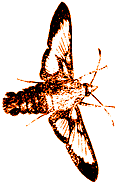 An undesirable garden guest would be a borer moth (Sessidae: Clearwing borer). |
 The caterpillar of a desirable butterfly such as the Mourning Cloak (Nymphalidae: Nymphalis antiopa) can, with only casual inspection, be mistaken for less desirable or more destructive relatives such as the gypsy moth (Lymantriidae: Lymantria dispar). |
Most butterfly species, such as the Tiger Swallowtail (Papilio glaucus), lay only a few eggs at a time. This low level of insect population will not kill shrubs or trees. However, Black Swallowtail (Papilionidae: Papilio polyxenes) larvae, for example, can completely consume herbaceous plants such as dill. To avoid killing a beautiful guest, you should be sure of your identification of an insect as a pest before using any pesticide.
A good side effect of the decrease in pesticide use is the increase of natural enemies. These are insects such as spiders, lacewings, ladybird beetles, and ground beetles that actually help to control unwanted pests.
|
|
Enjoy Your Garden |
|
|
Back to Table of Contents |